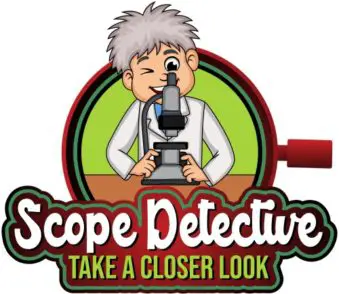The head of a microscope is the top section of the microscopes. It holds the ocular tubes and eyepieces of a microscope. It sits on the arm of the microscope and above the rotating objective turret.
There are three types of microscope head:
- Monocular
- Binocular
- Trinocular
But, there are also specially designed microscope heads with additional features, such as the Siedentopf head microscope, which I discuss later.
One of the most important questions many people have before buying a microscope is whether to buy a monocular, binocular or trinocular microscope. Below, I outline what I see as the pros and cons of each type.
> This article is from my series on Microscope Parts
Types of Microscope Heads
1. Monocular Head
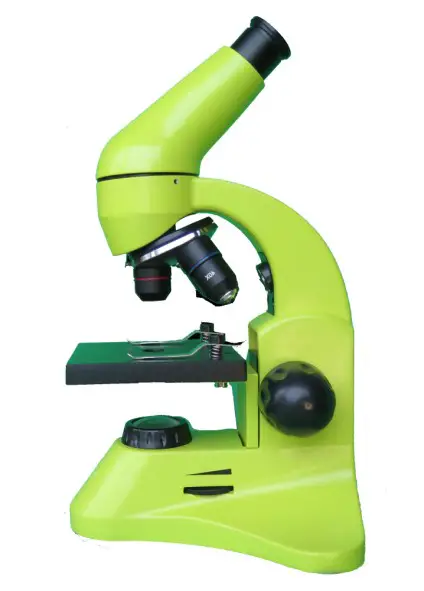
A monocular head contains only one eyepiece. It is the most common type of compound light microscope found in middle school labs because these are usually the cheapest compound microscopes you can buy.
It makes sense that they’re cheap – you only have to buy one eyepiece rather than a set.
You’ll also find monocular heads on microscopes designed to be portable. The size difference between a compact monocular microscope and a lab-ready trinocular microscope is quite significant.
Benefits
Many children find monocular microscopes easier to use than binocular ones, because there is less dexterity required.
They’re also generally more affordable than other types of compound microscope. This is, in part, because there are less parts on them. But it’s also simply the case that to get a microscope into the cheaper sub- $100 category, cutbacks are required – and one of the easiest cut backs is to cut down to one ocular tube.
Downsides
You will have trouble finding a high quality monocular compound light microscope. Once you reach the intermediate range of $150 or above, nearly all compound microscopes come with binocular heads. This is a factor of market demand: most people who use microscopes regularly prefer binocular microscopes.
I also personally find monocular microscopes to cause more strain on my eyes than binocular models. To avoid eye strain, try to keep both eyes open (contrary to what my site’s little logo scientist is doing!).
2. Binocular Head
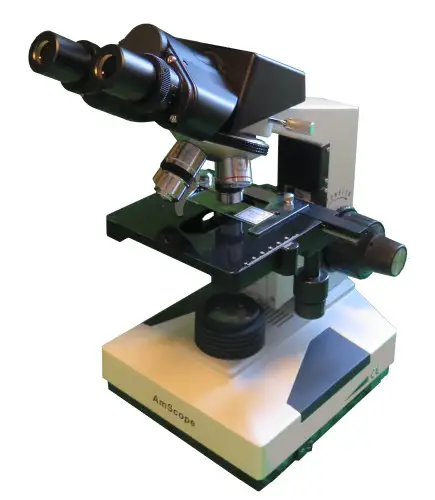 Binocular head microscopes are the most common type of compound light microscope. They provide two eyepieces so you can look into the microscope with both eyes at once.
Binocular head microscopes are the most common type of compound light microscope. They provide two eyepieces so you can look into the microscope with both eyes at once.
While there are two eyepieces, you’re getting the exact same image – reflected off mirrors – being delivered to both eyes when using a binocular compound microscope.
Stereo microscopes are also usually binocular, although if you look hard enough you can monocular stereo microscopes.
Features
There are some additional features worth talking about with binocular microscopes.
For example, you’ll usually find a diopter on one or both of the lenses. A diopter is used for people who have different vision in each eye. Instead of wearing glasses, you can use the diopter to make small focus adjustments on just one eyepiece. This allows people who usually wear glasses to look through the microscope without them.
Another key feature is the interpupillary distance adjuster. In layman’s terms, this is how you adjust the two eyepieces so they’re a comfortable distance apart for your eyes.
You can either use a sliding eyepiece mechanism or Siedentopf head. A Siedentopf head does not compromise focus when adjusting the eyepieces, which makes it superior.
Benefits
For me, the biggest benefit of a binocular microscope is that it reduces eye strain compared to a monocular microscope. It’s simply easier on the eyes when they’re both looking at the specimen.
You’ll also find that it’s hard to find a monocular microscope with higher magnification for oil immersion methods or a quality condenser. There’s no causation here, but in general binocular heads are placed on higher quality microscopes overall.
Downsides
It’s harder to share binocular microscopes. Adjustments are required for interpupillary distance and sometimes also the diopter for each user.
Furthermore, when adjusting the interpupillary distance between the eyepieces, you may lose some focus. To manage this, it’s best to get a Siedentopf head microscope.
Attaching a camera to a binocular microscope is very awkward, so I’d strongly recommend a trinocular microscope if you plan on taking photographs of your projects.
In general, a binocular microscope will also be more expensive than an equivalent monocular microscope because the extra ocular tube and eyepiece will have a cost associated with them.
3. Trinocular Head
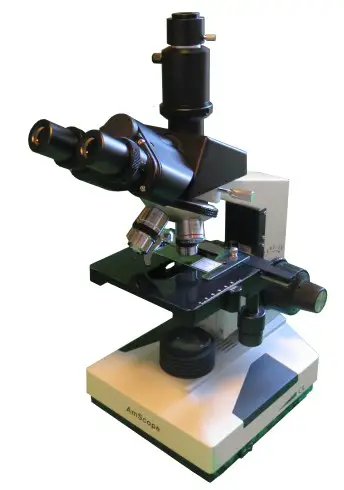 My workhorse microscope – my Amscope T490B – is a trinocular microscope.
My workhorse microscope – my Amscope T490B – is a trinocular microscope.
Trinocular head microscopes have both a binocular head as well as a third ocular tube for installing a camera. This tube usually points directly up to allow a camera to easily balance on the tube.
Benefits
The key benefit of a trinocular microscope is that it is ready for the installation of a camera. You can either get a dedicated USB microscope camera (make sure it’s USB 3.0 and at least 5MP) or a DSLR adapter so you can plug your DSLR camera into the tube.
Downsides
Trinocular heads generally add another cost to your microscope. And unless you’re planning on taking photographs, there’s little point in getting a trinocular microscope. But with that said, most people who but a binocular microscope end up wanting to take photos and regret not getting a trinocular head.
They’re also generally larger than other types of microscope.
With that said, I usually recommend a trinocular microscope to most users.
Other Considerations
Siedentopf vs Sliding Head
Sliding binocular head microscopes adjust the interpupillary distance of the eyepieces by ‘sliding’ them closer and farther apart. But a Siedentopf head binocular microscope allows you to adjust the interpupillary distance from a central axis, which has less of a negative effect on the focus [1]. This makes it a superior type of binocular microscope head. You can get Siedentopf heads on both binocular and trinocular microscopes. Below is an image of a Siedentopf microscope head. Notice how you can pinch it just like a pair of binoculars to get it comfortable:
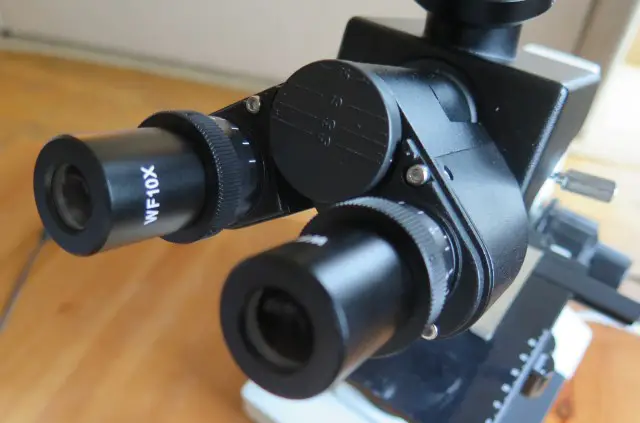
> Read more about Siedentopf head microscopes here
360 Degree Swiveling Head
Most intermediate to advanced compound light microscopes used in labs today have 360 degree rotating heads, which allow you to move the head for comfort or to share the microscope with a peer or student.
Ocular Tube Lean
The ocular tubes on a microscope will usually have an ergonomic lean of 30 to 45 degrees to reduce neck strain.
Conclusion
Overall, there are three types of microscope head: monocular, binocular and trinocular. Monocular microscopes are generally cheaper and for beginners, while binocular and trinocular are for intermediate to advanced users. A binocular head is more comfortable for your eyes for longer sessions. A trinocular head has all the benefits of a binocular head, but also has a third ocular tube for attaching a camera so you can take photos.
In general, I recommend monocular compound microscopes for kids and trinocular head microscopes for everyone else – because nearly everyone wants to take photos of their findings!
Hi, I’m Chris and I run things around here! I share all my microscopy experiments, microscope information and tricks, how to guides, and microscope reviews in the articles on this site. Browse around to see what you like (I recommend the experiment ideas section) or connect with me on any of the social platforms listed below.
